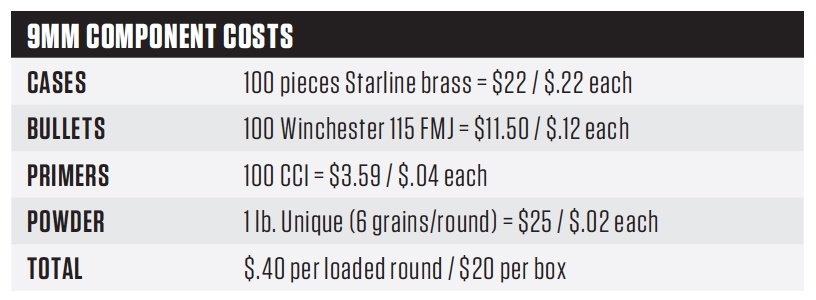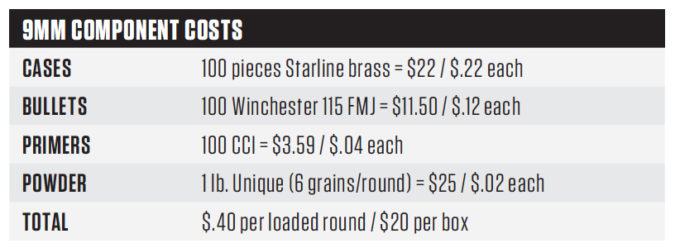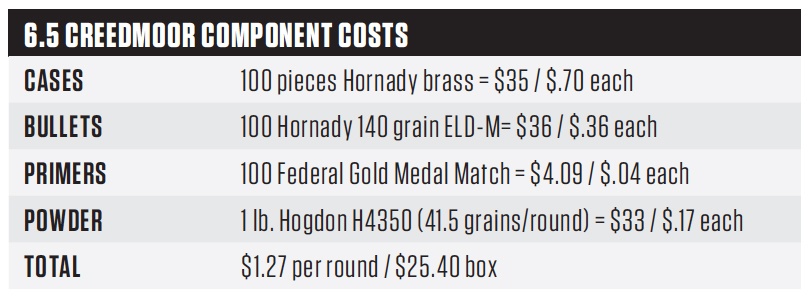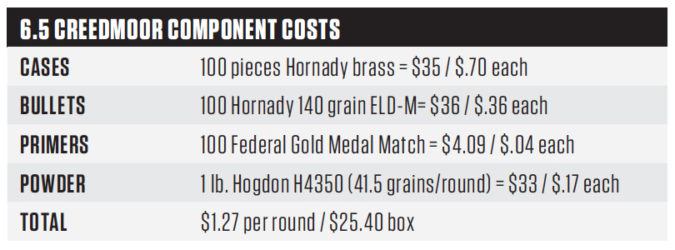Over just the last dozen years, ammunition prices have been as wild as a bucking bronco. They’ve ranged from dirt cheap (pre-Obama era) to paying a-dollar-a-shot for military surplus rifle rounds after Sandy Hook. Lately, prices have come down and appear to continue declining even as availability is on the upswing. In light of the changing price and availability dynamic, now’s a good time to look at the value proposition of rolling your own ammo.
There are more reasons to reload than saving money alone, so we’ll look at three common scenarios that bring shooters to the reloading bench: economy, performance, and necessity. We’ll cover the benefits of making your own 9mm FMJ rounds, 6.5 Creedmoor match ammo, and then something more obscure, 300 Ultra Mag hunting ammo.
Before we get too far along, let’s look at the cost of getting into a reloading setup. Currently you can find basic, single-stage reloading kits from companies such as Hornady, Redding, Lee, and RCBS for around $300. These include most of the tools needed to craft your own ammo, but you’ll have to add caliber-specific dies and perhaps a few other things. Regardless of what direction you go, figure on spending about $400 to get the tools needed to get started. Of course, this is before any of the consumable (bullets, primers, etc.) or reusable (brass cases) components are purchased. To determine if reloading will be economically beneficial, you’ll have to invest and recoup this amount before you’ll see any savings that comes from reloading … but be warned, very few individuals start down this rabbit hole and end up saving money, because it’s a long dirty burrow you’re climbing down.
THE CASE FOR 9MM PRACTICE AMMO
9mm Luger pistol ammo is ubiquitous, and its pricing is down to almost pre-Obama era levels, $10 to $15 for a box of 50 cartridges. Bought in bulk, 9mm factory training rounds can be had for as little as $0.18 a pop, though you’re scraping the bottom of the Spam can at that price.
The fairest way to compare the cost of factory loaded ammo versus the home-spun stuff is to begin with all-new componentry. A quick note on powder: There are 7,000 grains of powder per pound, so to get the cost per round, divide 7,000 by the grains used in each cartridge and then divide the cost of the powder by how many cartridges can be loaded per pound for a total per-round powder cost.
All told, it’s significantly more expensive than factory ammo. But a key benefit of reloading (and the reason it’s called “reloading,” not “loading”) is that brass is reusable. So the cost of the next box of reloaded ammo drops considerably to about $0.18 per round, or $9 per box. Of course, these calculations assume buying components in lots of 100. If you buy components in bulk the pricing will drop, sometimes substantially.

If we’re just looking at 9mm as our measure, it’s hard to make reloading worth it from a strictly financial standpoint. If purchasing components in bulk, reusing brass a few times, and using powder loads that aren’t hard on the brass, it can pay for itself. But we haven’t factored in the value of the time spent sourcing, prepping, and loading our ammo, and that’s a considerable investment in itself. Another thought is availability. If you have the components on hand, if ammo becomes scarce, you’ll be sitting on easy street for some time.
LOADING FOR PERFORMANCE
Another thing to consider when contemplating loading your own ammo is the benefit of tailoring a load to suit a particular rifle and creating ammo that’s more accurate than we can purchase over the counter. This alone makes reloading for performance worth the effort. Let’s look at the economics of reloading the darling of the intermediate range rifle scene, 6.5 Creedmoor. Whether it’s match or expanding hunting rounds, 6.5CM is everywhere these days. Its popularity has led to an extremely competitive retail market for the round, and that’s great for consumers … but what about reloaders?
We calculate a total cost of $1.27 for each roll-your-own cartridge compared to about $1.50 for a round of factory-loaded Hornady ELD-M ammo. Aside from a significant savings on match day, let alone cheaper practice days, hand-loaded ammo comes with the ability to customize the load’s bullet seating depth, powder charge, and componentry for maximum accuracy and reliability in your rifle.
While this example shows significant savings, it requires a considerable amount of time to develop a load that competes with factory offerings, unless you’re just lucky enough to hit the ball out of the ballpark on your first time up at bat. Generally speaking, load development takes anywhere from 40 to 200 rounds to wrangle the most out of your rifle, especially if you’re attempting to wring out every single ounce of performance, like bug-hole groups, extreme spreads in the single digits, and lightning-fast muzzle velocities. The only way those ends are achieved is from many hours at the loading and shooting benches. The time can add up over the course of a few weeks.
A quick note on wringing out low extreme spreads and standard deviation values (geek-speak for more consistent velocities) on reloads compared to factory ammo. It’s not hard to get better numbers than you’d get from factory ammo, especially if you’re using top flight componentry and weight-sorting both brass and bullets. But some factory ammo is cheap enough and consistent enough to make the margin between factory and reloaded ammo pretty thin. So, do some homework and make sure you factor in the cost of your time when deciding if reloading is worth it.

COMPELLED BY SCARCITY OR OBSCURITY
Let’s look at 300 Remington Ultra Mag, using Nosler Trophy Grade ammo loaded with its 180-grain Accubond bullet. It costs around $80 for a box of 20 cartridges, or $4 a pop, compared to $2.71 for DIY.

So, it would appear reloading obscure hunting cartridges is a tremendous value and a fine way to justify a few hundred bucks in reloading equipment … until we realize how few 300 RUM rounds the typical hunter uses in a year. Figure three to five rounds to check zero, add a few more for troubleshooting the occasional malfunction, then add anywhere from one to three rounds to take a big game animal … that’s only 10 rounds a year for a big-game hunter. But, even at 10 rounds a year, we’re still saving money and maximizing accuracy by tailoring the load to our rifle. We just need to accept it’ll take awhile to recoup the cost of our reloading equipment.

BRASS TACKS
In each of the examples above, we calculated the per-round cost using virgin brass. But reloads are exactly that. Collecting and reusing the brass from your last shooting excursion provide considerable savings since you don’t have to buy it each time. Brass cases are reusable anywhere from six to 15 times, depending on the pressure of the individual loads and the care taken in handling the brass itself. In the 6.5 Creedmoor example, the price per box using reloaded brass drops from $18.40 to $11.40, a $20.59 savings over factory ammo. The savings on 300 RUM using recycled brass is even greater, dropping from $39.20 per box to $17.20, saving $68.59 over purchasing factory ammo.
Judging by economics alone, reloading ammunition can be a worthwhile endeavor depending on the cartridge you’re loading. But knowledge is where it really pays off. Developing and loading your own ammo is the absolute best way to unlock the mysteries of accuracy and reliability, ultimately elevating every shooter’s ballistic abilities. You’ll never watch enough videos or read enough articles to match what you’ll learn about guns after just one cycle of load development.
That being said, while you’ll learn a lot, by the time you’ve invested in all the gear it can be a financial wash. For 9mm, it’s not necessarily any cheaper, and as shown if time is added into the equation, the reloader ends up upside down. Loading your own 6.5 Creedmoor can save you a few bucks while maximizing the cartridge’s performance. And, finally, once you step into obscure cartridges with premium projectiles, the finances will eventually favor you, but what you really gain is the ability to shoot without the hassle of tracking down and/or waiting for tough-to-find ammo to appear in stock at your retailer.
Finally, reloading ammo is a hobby by itself for a lot of people. It’ll extend the pleasure of concentration from just the time on the range, to the loving (or maddening) task of building rounds that stack bullets neatly in one hole. Conversely, if detail-oriented and fairly monotonous hobbies aren’t your idea of fun, today’s factory ammo is better than it’s ever been. Whether looking for savings or performance, you can’t make a bad choice.









































![Air gun 101: The differences between .177 & .22 – Which jobs they do best ? [Infographic]](https://airgunmaniac.com/wp-content/uploads/2020/09/g44-150x150.jpg)

